Buckwheat: Eat It Like A Russian
Why A Buckwheat?
I know you heard about buckwheat. It is a ‘healthy grain’ that doesn’t contain gluten, but is rich in protein and iron. You can find in organic cereals, bread and pastry. Raw folks sprout it and the French make their famous galettes. Blah-blah. You probably know it already.
By the way, do you know buckwheat isn’t a cereal at all? Wheat, rice, millet, oats, barley, corn and rye, they all are Monocotyledons (Poaceae family), while buckwheat comes from Polygonaceae family and is a Dicotyledon (together with amaranth and quinoa also known as healthy grains).
Now let us finish with botany and start some real talk.
Brown vs. Green
Buckwheat (‘grechka’ or ‘grecha’) is very common in Russia. You won’t believe me, but we even have a very popular monodiet where all you’re supposed to eat is plain cooked buckwheat (sometimes without salt)! Ha-ha. But that isn’t how you should use buckwheat anyway.
Let’s look how buckwheat looks like here – you gotta be surpised.
Yep, it’s brown – because it’s roasted.
This difference is familiar to every Russian who ever tried to buy buckwheat abroad. In healthy shops in Europe and America you probably see something like this:
Green (not roasted) buckwheat is actually very good too. You can sprout it which is impossible with roasted one. But it tastes differently, it’s not typisch Russisch and it’ll get mushy after cooking. Buckwheat we eat in Russia is nice and fluffy so you can see every little grain.
Don’t worry. Wherever in Europe/North America you are, there’re probably some Russians too. In that case, there are Russian shops somewhere. You can get a real stuff there.
Put On Your Apron
Cooking buckwheat is so simple even kids can do it. You only need to follow these rules:
#1. Stick to 1:2 (volume) ratio of buckwheat and water. That means you need to take 2 cups of water for 1 cup of dry buckwheat (you gonna have a BIG pot of it!). Put some salt in water.
#2. Put buckwheat in water only when it boils (not at the beginning!). Note: you need a pot with a tight lid.
#3. When you’ve done with #2, let the water boil for the second time, then reduce heat to very low.
#4. After that, forget about it for 15 – 20 minutes. If you still want to check, you should see fluffy grains on top and no water within view. After that turn the heat off and let the super-duper-grain stay covered for another 10 – 20 minutes.
You should see something like that then:
Fluff it slightly with a fork:
And now it’s ready to be eaten!
Note: it’s ok with buckwheat if you undercook it (leave some water on the bottom) if you let it stay with heat off. Some people even simply pour boiled water on the grains and let it stay overnight (or some hours). But it’s not how it’s commonly done.
Quick Note On Fats
Since buckwheat is so fluffy and a little dry you definitely want to put some fats in it. (Or sauces. Or both.)
First of all, olive oil came to Russia not that long ago. So I suggest you save it for other dishes.
I heard about idea that you can get real Russian taste of buckwheat porridge only if you add butter. I’d tell you I quite agree with it, although I usually add ghee (just because I mostly have ghee on hand). Or clarified butter. And you don’t even need much of it: 4 – 10 g per portion would work very well.
Note: animal fat (e.g. from poultry) pairs very well with buckwheat too.
Butter is probably the best option. But sometimes we dress it with oils too. It’s mostly those crappy plant-based and tasteless oils and they don’t add anything to a taste. What I personally like is another typical Russian food item – unrefined sunflower seed oil. It has very peculiar taste of roasted sunflower seeds and it’s really good paired with buckwheat. (Sounds interesting? I bet they have it in Russian shop!)
If you want to season your buckwheat with fats (I hope you get that you should), do it when you turn off the heat (so the butter would melt nicely), when fluffing or right in your plate.
Legit Ways To Eat Buckwheat
There are 3 most common ways to eat your awesome kasha:
1. On it’s own (purist way)
2. As a side (for meat, poultry)
3. As a milk porridge
Let’s dig into it.
Eating plain buckwheat is probably the oldest way. The minimum you need is a butter or oil, as I mentioned above. Other good options are:
– chopped greens (green onion, dill, parsley, basil)
– dried mushroom flakes (preferably Russian mushroom, of course) or sautéed fresh mushrooms
– some sautéed or caramelized onion (yum!)
– chopped hardboiled egg
– any gravy you happened to have
Awesome. Only some chopped greens on top could have made it even better.
Despite high class cooks educating about veggies being the best side, here in Russia thousands of people still believe in Soviet-style sides. Those are: mashed potatoes, rice, buckwheat and pasta. But I won’t lie, buckwheat goes very well with beef, pork and poultry as well as with meatballs and burgers from them. It’s not that good with fish though.
Buckwheat, homemade beef stroganoff, gravy and some veggies. Perfect combo.
Note: I won’t recommend cooking buckwheat pilaf-style (in one pot with other ingredients such as meat, veggies etc.). It gets soggy that way.
I’m firm believer in savory buckwheat, but many people do like their buckwheat sweetened (again, it’s Soviet heritage). Funny thing is you don’t need to cook buckwheat in milk for a porridge. You just heat a milk and then pour it over cooked buckwheat, as you do with any cereals. You may add some sugar or a piece of butter to it (I skip it).
Not the best pic, but hopefully you get the idea.
Of course, there are other ways to use of buckwheat. Sometimes it’s used for stuffing (e.g. pies) or you can use leftovers to make a bake or burgers. But it’s not that common on an average Jane’s kitchen.
Wow, this post turned to be kinda long, huh? Thanks for staying with me till the end. And if you have any suggestion or thoughts, feel free to contact me, I’d LOVE to have any feedback from my readers.
image credit (for green buckwheat): http://debbrunson.com

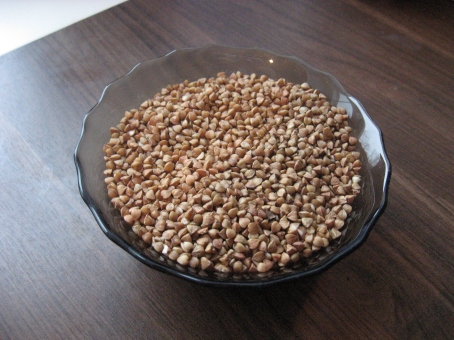
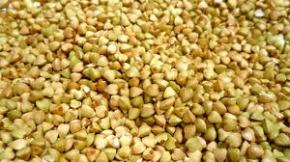

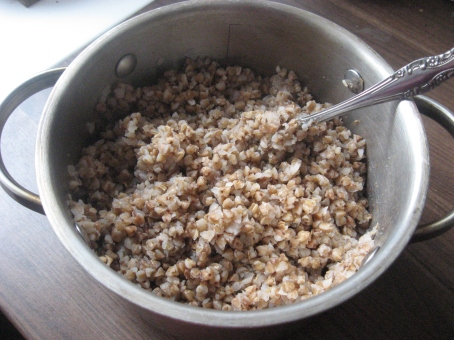
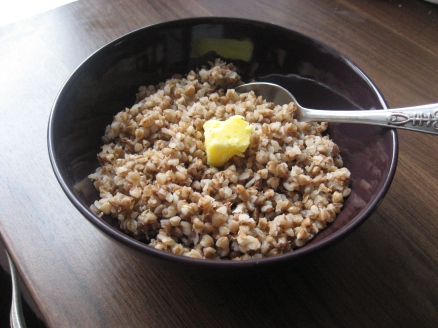
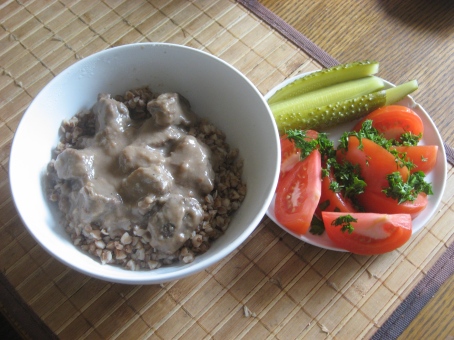
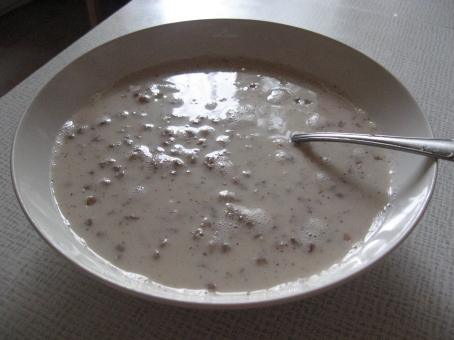
Pingback: Tvorog: Where Russians Get Their Protein | healthyhappyhelping
I actually prefer raw (sprouted) buckwheat. I ate plenty of it growing up in Russia and it’s strong taste is not my favorite… However, sprouted, it still has all the benefits, much more mild taste and can be bade into a sweet or savory dish! More over, my sweetheart partakes in road bike races. His body response to sprouted BW is that he can go faster longer without suffering a sudden drop in power throughout his ride! Let me know if you’d like some recipes for your collection.
Hi Eugenia! I agree that roasted buckwheat has very specific flavour and probably not everyone would like it if they never tried before. Now we can actually buy green buckwheat here, although I never tried it. I heard people sprout or soak it, but to be honest, I think it takes much time and hustle. Am I right? Do you have any recipes that don’t require long prep?
HI Alena, thank you for the response! 🙂 Yes, you need the green buckwheat for sprouting. And, yes, I also thought it was going to be a lot of hustle… But it is a pretty easy thing and it adds a little bit of rhythm to the day.
Step 1: have enough BW in the bowl for a couple of servings (once it gets into sprouting, it is good for a couple of days) pour room temp water over it covering it completely.
Step 2: As the grain sits in water throughout the day(~5-7hrs), it will get slimy (the slime is the enzymes that all seeds have and use it to prevent being digested and helps it slide down the digestive tract with ease, if it was swallowed intact; the plant wants to travel further and get planted, rather than nourish all birds and animals that might eat it.) in the evening take a fine mesh strainer, pour your BW into the strainer and rinse it few times under the running water. Leave the BW in the strainer till morning (~10hrs) I prefer to drain BW well, so when I add my dressing to it, it coats well and the taste is not watery.
Step 3: In the morning you will see the BW kernels will have little white ‘beaks’. You are DONE! It is ready to be made into a sweet or savory dish. The ‘beaks’ are the roots, will continue to grow and are fine to eat for a few days. If you let them sit for too long, they will dry out, (and you can actually dry them out for power bars or crusts) or if it is humid enough, they will continue to grow and get all fuzzy (at that point they don’t look very appealing to me). Unless it is really hot, I don’t refrigerate sprouts.
For sweet and savory version I start with squeezing half a lemon or a whole one into the BW, mixing it thoroughly, letting it sit for 10-20 min. Acid will begin ‘cooking’ process and will make it even easier to digest (and remember, we already got rid of the digestion preventive enzymes)
For Sweet I add a little bit of honey, dice whatever fruit is handy, add whatever berries are around; it looks gorgeous! And tastes great!
For Savory, I make dressing of Bragg’s amino acids, olive oil(sunflower will work nicely too), might add a dash of unfiltered apple cider (especially if I serve grilled meat with it), some fresh herbs, if any around (parsley, dill, cilantro are the easy ones) (if your kissing partner is enjoying the meal with you, you might like adding fresh garlic, otherwise, I don’t recommend it 🙂 you can also dice and add zucchini, grate in a carrot, shave in some cabbage… Improvise! ENJOY! … and always have fun! 😀 I am not a nutrition nut, I’m a foodie and a branding nut, so whatever I eat has to taste good and look even better. 🙂
What portion of Buck wheat do you eat, is it a palm full or does it not matter. Need to know ad I am a diabetic
oh, here is mu Instagram pic of it… http://instagram.com/p/MI4UIDvDMK/
Hey, looks nice!
I’ve found green buckwheat in a shop just nearby, so I’m gonna give it a try when I run out my regular buckwheat!
Dear Lady,
Your information is quite impressive and you seem to be very considerate. The way you explain and take pains, your husband might be a lucky man.
Right now I will switch off the computer and go to the market for searching BW as few days back I started taking gluten free diet.
Regards.
Rajesh
Thank you for your fun, whimsical educational post on buckwheat. Do you happen to know the protein ratio?
Sure. The information on the packages varies, but it’s something about 12.5-13g protein for 100g of dry roasted buckwheat. It also has around 2.6-3.3g of fat and 68-70g of carbs. Obviously the numbers will be different for cooked buckwheat (around 4.2g of protein for 100g). In any case, I can assure you that buckwheat is a staple among most Russian athletes (and bodybuilders in particular) as it contains quality plant protein and essential amino-acids.
Pingback: Why My Slow Cooker Is Better Than Yours | healthyhappyhelping
Pingback: Pumpkin you haven’t eaten | healthyhappyhelping
hi,i am an indian student doing med studies in ukraine…and i am a vegetarian and have pcod……so it was very difficult to find healthy and filling foods in extereme colds…….grechka was my super resscue for all meals of the day.
especially with its d-chiro inositol and zinc magnesium contents
very nicely written and very authentically soviet style of eating grechka.
Thank you for your feedback!
If you’re in Ukraine, I would also suggest trying vegetarian version of borsch (it exists!) – it’s also warming and filling.
A “1:2 (volume) ratio of water and buckwheat” means 1 cup of water to 2 cups of buckwheat. This is the opposite of what you say it means: “you need to take 2 cups of water for 1 cup of dry buckwheat”. I suspect you meant to say that you need a “2:1 (volume) ratio of water and buckwheat”?
My bad. Thank you for correction!
I stayed with a family in Moscow and I believe they served me a savory buckwheat porridge, which I found to be delicious. I have been searching for information and you have helped me. This is a healthier alternative to the typical American sweetened cereals. I will be cooking some very soon.
I’m glad it was useful! Just don’t forget that you need a roasted buckwheat (brown), not the green one, to cook that typical Russian kasha.
Hi Aloyna, great post. After the green buckwheat has been sprouted and drained, is the cooking process the same as the one you’ve outlined for roasted buckwheat?
Hi Carlo! To be honest, I don’t have any experience with green buckwheat. But if you sprout it, you probably don’t want to cook it at all. The idea of sprouting is that you can eat it raw. And if you simply want to cook green buckwheat, then don’t sprout it. These are just my guesses and I may be wrong!
Thanks Aloyna for the quick reply; I think this post is the most valuable internet resource on buckwheat for English speakers! Like a previous commenter (Teri, 21 Jan 2015), I first came across buckwheat porridge while touristing in Moscow (2012). I’ve followed the exact same cooking procedure for green buckwheat that’s been soaked overnight in the fridge, rinsed and drained. That is, boil twice the weight of water, then simmer BW for 20 mins. I’ve used it for porridge; a little mushy (as you’ve indicated) – the taste is perfectly acceptable. However, as a newcomer to buckwheat porridge, I’ve not yet tried it with roasted BW. Need to get through this batch of green first, but when i get to it, I’ll repost here and let you know how I get on 🙂
I’m glad my post helped you, Carlo! And I definitely didn’t expect that so many people find it useful (for us Russians cooking buckwheat is pretty much like scrambled eggs – no instructions needed). Would love to hear about your experience with roasted buckwheat as well.
Thanks for this post, Alena, and all the helpful information about how Russians make and eat kasha.
In the United States, Wolff’s Kasha (roasted buckwheat groats) are available in supermarkets, at least in New York State. It goes on sale at the time of the Jewish holidays.
There are some unusual recipes at Woff’s site, http://www.thebirkettmills.com/Recipes.asp.
I like kasha with butter the best. I got some green buckwheat groats in a health food store and want to sprout them.
Best wishes to all!
I checked Wolff’s Kasha in google and it really looks like what we have in Russia (nice brown & roasted). Recipes are, indeed, unusual! Mexican-style Kasha made me smile.
I like Kasha with butter too. In my opinion, buckwheat is not as universal as rice or pasta. It isn’t tasty when cold (e.g. in salads), doesn’t work soups or stews (unless you like it very mushy) and is better eaten savoury, not sweet (with few possible exceptions). It also goes very well with cream sauce, be it mushrooms, beef or chicken.
Aloyna, Sorry I made a mistake about your name. Now I have it right. Thanks again for giving us an interesting look at Russians and cooking.
I have once said if there was only one type of food left on earth, let it be Buckwheat! I have eaten buckwheat since I remember, but when it came to cooking it I found it too long of a process. My grandma always covered the pan in a blanket for few hours (?!? Seriously). I have found much quicker way – use the steamer ! Steamer must have a rice bowl and cooking is very much the same as rice: 1:1 ratio of buckwheat and water, but allow space for it to expand, add salt and cook for about 40-45 min. Easy! Steamer turns itself off so can be left unattended. Quick and simple – enjoy.
Looks like you really enjoy your buckwheat, Ewa! I have no experience with steamers, but I use a slow cooker to prepare it.
Hi Aloyna,
Recently got some roasted buckwheat/kasha from a local healthstore.
You’re right, it’s more ‘solid’ than the green BW, and while they taste similar, the roasted one is less mushy when cooked. It has a slightly smoky/burnt taste. They’re both good, but all in all I prefer the traditional, roasted one.
I allowed 200ml water for 75g buckwheat and simmered for 20 minutes.
I’ve used all my buckwheat thus far for porridge, must try some other combinations too!
Thanks for an update, Carlo! I’m guessing you like buckwheat if you’ve used it all up 🙂
I suggest you try it with mushrooms or beef and a creamy sauce – it’s my favorite way of eating it. (Pork and chicken would work too)
I’m having such fun experimenting with BW! I have a Russian neighbor, she’s 91 and I still have not got the ratio just right for my taste or I’m cooking too long. I will continue experimenting. I’m having it for breakfast with a lightly cooked apple and cinnamon, cardamom and a little coconut milk. I would like to know about how much protein would be in a 6 oz serving. Thank you for all your information.
Sorry, Ruah, my answer to you seemed to disappear 😦 So here it is again.
Eating buckwheat as something sweet is not very common in Russia, but there are certainly ways to experiment! If you haven’t already (and assuming you have roasted buckwheat), try cooking it as usual (2 parts water for 1 part buckwheat, adding it only when water boils) and then add all the toppings vs. cooking it in coconut milk.
According to Myfitnesspal there is about 9g of protein in 6oz of buckwheat cooked in water.
Pingback: 5 Delicious Dishes To Make From Russia | Western Union Blog
Pingback: Compiled Recipe – Buckwheat Porridge with Mushrooms In A Crock Pot | araalfaro415
Adding some experiences of an American amateur buckwheat eater…
You can usually get green or roasted buckwheat in health food stores.
If you don’t have roasted buckwheat groats, you can roast them easily in a fry pan on the stove.
A friend used to roast green buckwheat groats until brown, then he’d mix tamari and cayenne pepper into a small amount of water, throw it over the toasted buckwheat and stir until dry, for a crunchy, savory Sunday morning breakfast treat.
For breakfast, buckwheat cream can be made similar to rice cream or cream of wheat. Just grind some roasted buckwheat groats in a coffee grinder or blender and cook in water. Very nice. You only need a few tablespoons of ground buckwheat for each serving in a cup or more of water. Butter and honey are good on top.
Green buckwheat can be used to make wonderful pancakes and waffles. I mix it with amaranth or oats, all of which are easy to grind in a coffee grinder or blender. I grind them together, then add an egg and maybe a little milk or water, a little honey or maple syrup, etc… instant pancake batter! Drop batter on a hot griddle or fry pan to make small rounds. When bubbles appear on the surface, flip and cook the other side. Smother with butter and maple syrup.
Sprouted green buckwheat groats can be mixed with Italian seasonings and formed into a dehydrated pizza crust… then covered with tasty toppings such as basil pesto, dried tomatoes blended with fresh tomatoes for a pizza sauce, thinly sliced veggies, etc.
Sprouted buckwheat can be used in tabouli, rather than couscous.
Buckwheat is a wonderful, wonderful food.
Thank you for these wonderful ideas, Patricia, they are very creative!
I never tried “cream of buckwheat” this way, but we do have some buckwheat flakes, similar to oatmeal, that can be cooked the same way (in water, milk etc.) and served as a hot cereal. You may find these flakes in Russian or Finnish stores (Finns seem to love their hot cereals, too).
Also, pancakes made from green buckwheat sound fun, but I wouldn’t recommend making pancakes with roasted buckwheat flour, homemade or store-bought, unless you add a generous amount of regular flour (at least twice the amount of buckwheat). I can’t tell you how many attempts I had to make 100% buckwheat pancakes, but they never turned out edible, not to mention tasty. May be we have different buckwheat flour here in Russia.
When it comes to making pancakes from buckwheat flour – French are the masters. They make savoury crepes, called Galette – and they are very easy to make and can contain variety of topics.

Hi Alena,
Thank you so much for the info on how to cook buckwheat the Russian way. I have a couple of friends in Peter and they have convinced me to try it.
One thing I was curious if you have tried…have you tried cooking the buckwheat in something besides water? Maybe like chicken broth or beef broth? I have been doing this with rice recently, and the results have been delicious rice with no need to add anything else. I wonder if it would work for buckwheat as well?
Have you tried it? If yes, what did you think of the results?
Thanks again!
Hi Don,
Sure, both chicken and beef broth would work well with the buckwheat, just use the same ratio as with water (or you can mix it with water, e.g. when you have 1/2 cup of leftover broth). I bet vegetable and mushrooms broths will be okay too. What I wouldn’t recommend is cooking the buckwheat in milk unless you want a very mushy porridge (and use 3-4 parts of water for 1 part of buckwheat), and even then it’s probably not the best idea. I’d also say that fish/seafood broth doesn’t really agree with buckwheat for my taste.
Hope you’ll try and like the buckwheat!
Pingback: London Language Lab | Word of the day: Harry Pottered out!
Hi Alena:
We are a US organic processor of sprouted grains, which we use produce to make into baby cereal, flour and a smoothie mix. I’d love to share samples of our products with you. which include buckwheat, brown rice, oat, wheat, and quinoa baby cereal. We also have flax, wheat, multi grain, brown rice, and barley flour. Our smoothie mix is a combination of our multi grain and buckwheat. It is a great product for meal replacement and very nutritious. You may check us out at http://www.allsprouts.com. My email is krisl@nethtc.net.
Thanks, nice blog, very interesting!
I have read that kasha is considered a seed from the buckwheat plant which is a flouring fruit plant similar to rhubarb. I wonder why we don’t make use of the fruit of the plant.
Yes, I know that buckwheat is not technically a grain/cereal, it juts looks like it. I’m not sure about the fruit though. My guess is, if it was edible and tasty, people probably would be cooking it as well.
Some really good info here. Thanks for the tips! Glad I bought the roasted stuff now :D.
My pleasure!
I just finished a lunch of buckwheat I prepared as you described, Alena, 2 parts water, 1 part buckwheat and a touch of salt. Then I folded it into my asparagus soup and let it simmer for 5 or 6 minutes, after the soup had been already been simmering with a couple ham hocks in it for an hour.
Delicious!
I prepared about 6 serving and froze 5.
I’m glad you like it, Ziv!
Pingback: 14 Frugal Pantry Staples You Need To Save Money on the Groceries
I am just watching a Polish movie set in 1988. They just went to the cantine for meatloaf, cucumber salad, buckwheat and gravy, with punch on the side. I thought to google what the taste of buckwheat is and found your page. Thank you for your great description. There is a Polish sklep near me, so perhaps they will have buckwheat.
Hey Alex,
I’m glad you found this post useful. The meal you described sounds a lot like something you may have in a cafe here serving Russian/Soviet food, except there would probably be kotlety instead of a meatloaf (meat patties that really are just single-serve meatloaves). Polish and Russian cuisines have a lot of similar dishes. Hope you’ll find buckwheat and like it!
Pingback: Dinner Dates: Onfim (12th – 13th century CE) | Pass The Flamingo: Ancient Food History and Recipes
I was inspired by your page, so I made some buckwheat. Oh Wow, it’s good. I had mine with some fresh spinach. Thank you!!
I am glad you liked it!
I love roasted buckwheat kasha! Its my everyday lunch now!
Thanks for the info – interesting and authentic! One little comment though – BW is delicious in soups, especially in combination with mushrooms (I am from Kiev, Ukraine; and on another note regarding the comment you left for another visitor – vegetarian borsch is popular in Ukraine – our family only makes vegetarian Borsch and it is delicious!!) 🙂
BW flour also makes a delicious bread (together with oat flour and flax seed).
Wow, I imagine a buckwheat soup with mushrooms must be good as buckwheat does pair very well with them.
I am not Russian and never been there but I know the difference between sprouted or green or brown buckwheat and I like both. However, I buy Wolffs buckwheat Because it is traditional Russian brown kind. It’s so good and I love it plain with only butter. Or I mix in some pasta. Or I mix it into filler for meatloaf for my dog other who eats meat. I made burgers from it too. The green stuff I use as a side dish. The brown for everything. I guess you don’t need to be from that part of the world, or have grown up eating something to love it once you try it. I am Mexican and Italian and from the US/Canadian border area of USA. I love all kinds of foreign things. Russian cuisine is so meat heavy, otherwise I would eat it often, but I quit eating meats. I still eat animal products of other type tho so butter and a little creme fresh and brown buckwheat is awesome.
I just cooked roasted buckwheat really quickly (it goes soft), and added tahini (along with flax seed oil), and added kimchi (like sauerkraut a bit but more orange). I found it a surprisingly nice mix. (Also pink salt and black pepper.
What an unusual combination! I’m sure it was good though. I’m a big fan of pink salt and black pepper myself.